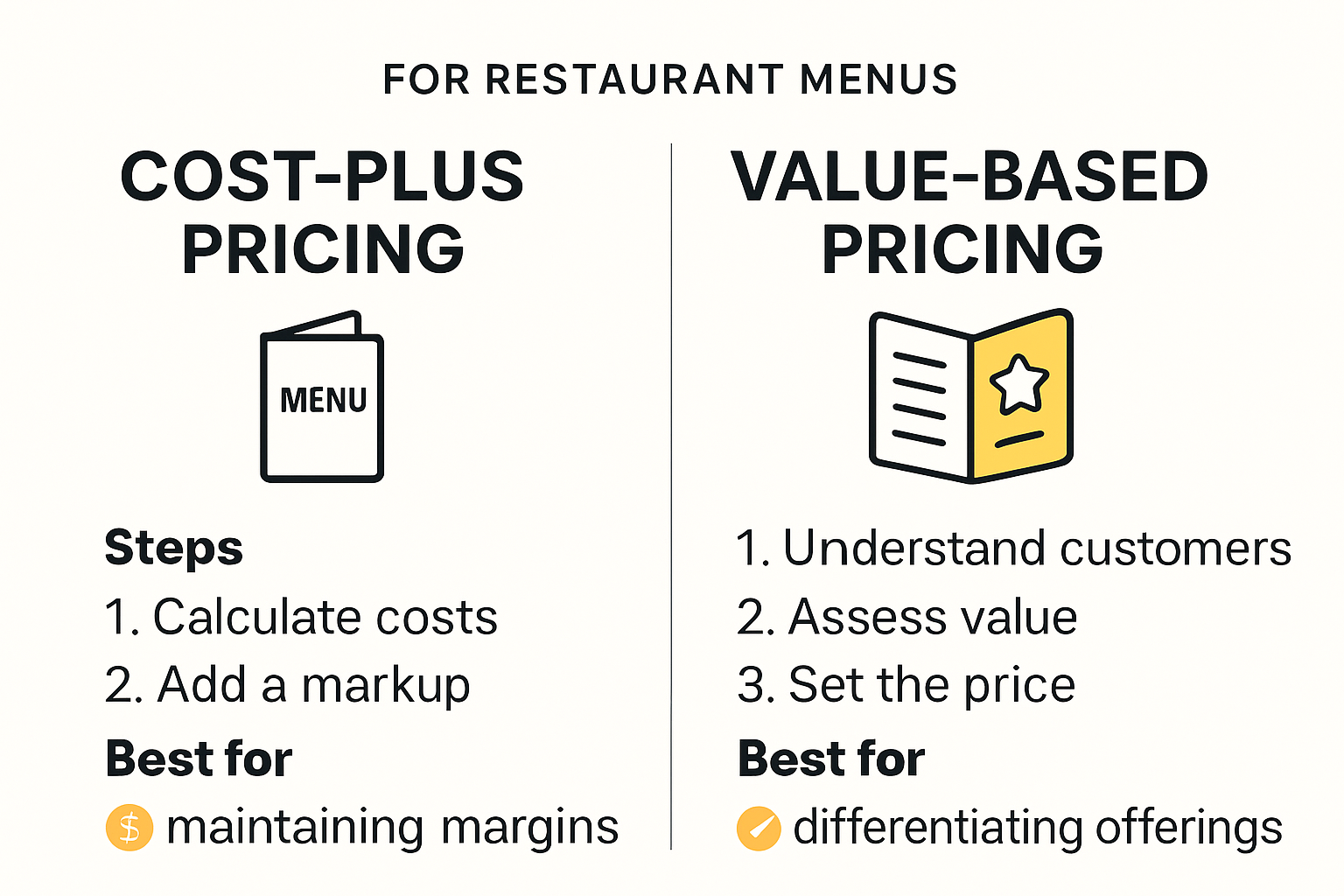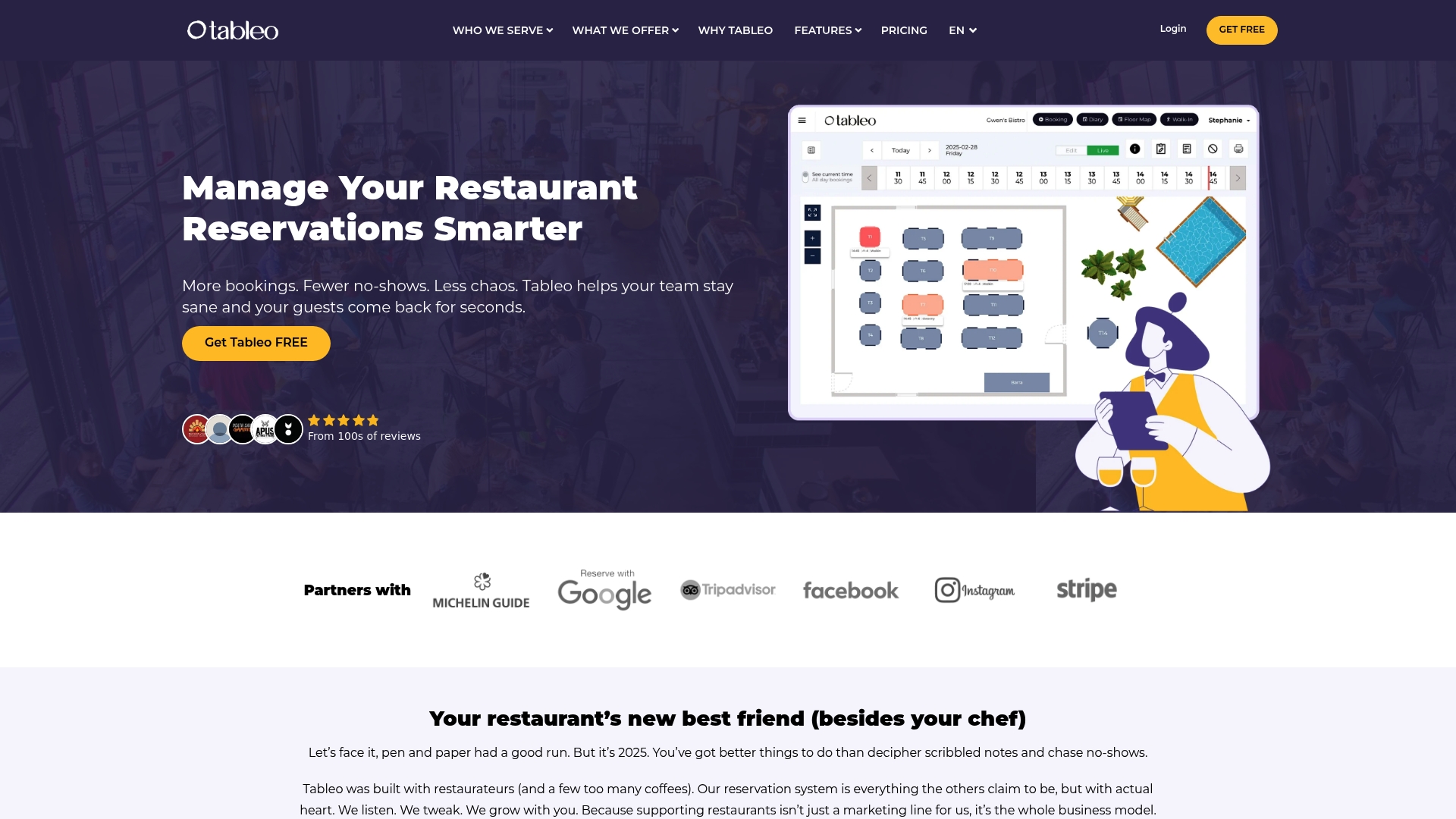Restaurant menu pricing looks simple but holds much more than meets the eye. Believe it or not, even a small change can have a big impact. Research shows that just a 1 percent price increase might drop customer ratings by up to 5 percent. Most people think pricing is just about adding up costs, but the smartest restaurants use psychological tricks and real-time data for a winning edge.
Table of contents
- Understanding Restaurant Menu Pricing Basics
- Key Methods To Calculate Menu Prices
- Effective Pricing Strategies For Different Restaurants
- Common Mistakes And How To Avoid Them
Quick summary
| Takeaway | Explanation |
|---|---|
| Menu pricing is dynamic | Successful restaurants view menu pricing as a continuous learning process, requiring regular analysis of food costs, market conditions, and customer feedback to remain competitive and profitable. |
| Cost-plus vs. value-based pricing | Understanding both Cost-Plus Pricing and Value-Based Pricing is essential; the former ensures foundational profitability, while the latter optimises pricing based on perceived customer value. |
| Psychological pricing techniques | Implementing pricing strategies that leverage customer perception, like pricing just below whole numbers, can subtly encourage higher spending and improve customer satisfaction. |
| Strategic considerations matter | Balancing food cost percentage, competitive positioning, and market dynamics is critical in formulating a pricing strategy that communicates value while ensuring sustainability. |
| Avoid common pricing mistakes | Identifying and addressing common pricing calculation errors and customer perception challenges can significantly impact a restaurant’s financial health and overall success. |
Understanding restaurant menu pricing basics
Restaurant menu pricing represents a critical strategic decision that directly impacts profitability, customer perception, and overall business sustainability. Successful pricing goes far beyond simply covering ingredient costs or matching competitor rates.
The core principles of Restaurant Menu Pricing
At its foundation, restaurant menu pricing involves a complex calculation that balances multiple financial and strategic considerations. Discover how strategic pricing can transform your restaurant’s revenue, restaurants must carefully analyze several interconnected factors.
According to NetSuite’s comprehensive pricing analysis, two primary pricing strategies dominate the industry:
Cost-plus pricing: Calculates total production expenses including ingredients, labour, overhead, and adds a predetermined profit margin. This method ensures basic financial sustainability by guaranteeing each menu item generates sufficient revenue.
Value-based pricing: Sets prices based on perceived customer value, considering factors like culinary quality, restaurant atmosphere, ingredient uniqueness, and overall dining experience. This approach recognizes that customers evaluate worth beyond raw ingredient costs.
Professional restaurateurs understand that pricing is not a static process but a dynamic strategy requiring continuous refinement. Unilever Food Solutions emphasizes the importance of menu engineering techniques that systematically analyze dish profitability and popularity.
Strategic considerations in menu pricing
Successful menu pricing requires restaurants to balance multiple strategic objectives. Restaurants must consider:
Food cost percentage: Typically restaurants aim to maintain food costs between 28-35% of menu price. This benchmark helps ensure operational sustainability while remaining competitive.
Market positioning: Pricing communicates a restaurant’s market segment. Premium pricing suggests high-quality ingredients and exceptional service, while competitive pricing attracts budget-conscious diners.
Competitive landscape: Understanding local market rates helps restaurants position their pricing strategically. This doesn’t mean mimicking competitors but intelligently differentiating through value proposition.
Modern restaurants increasingly leverage technology and data analytics to refine pricing strategies. Advanced restaurant management systems now offer dynamic pricing capabilities, allowing real-time adjustments based on demand, ingredient costs, and seasonal variations.
Ultimately, menu pricing is an art form blending financial mathematics, market psychology, and culinary creativity. Restaurateurs who master this complex discipline can transform pricing from a mere operational necessity into a powerful strategic tool for business growth and customer satisfaction.
The most successful restaurants view menu pricing not as a fixed calculation but as a continuous learning process. Regular analysis, customer feedback, and willingness to adapt ensure long-term financial health and competitive advantage.
To clarify the differences between the main menu pricing approaches, the following table compares their core features as discussed above:
| Pricing method | Basis for pricing | Key benefits | Considerations |
|---|---|---|---|
| Cost-Plus Pricing | Total cost (ingredients, labour, overhead) plus profit | Ensures baseline profitability | May overlook customer perception of value |
| Value-Based Pricing | Customer’s perceived value of dish/experience | Can support premium pricing & differentiation | Requires understanding customer preferences |
Key methods to calculate menu prices
Calculating menu prices requires a sophisticated approach that balances financial sustainability with market competitiveness. Restaurants must employ multiple strategic methods to develop pricing that supports profitability while meeting customer expectations.
Comprehensive cost analysis techniques
The foundational approach to menu pricing starts with thorough cost calculation. Learn about advanced pricing strategies that go beyond basic calculations. According to Menu Tiger’s restaurant pricing research, successful pricing involves multiple calculation methods:
Food cost percentage method: Restaurants calculate total ingredient costs and apply a standard markup. Typically, this involves dividing the dish’s raw ingredient cost by the target food cost percentage (usually 28-35%). For example, if a dish costs £5 in ingredients and the target food cost is 30%, the menu price would be approximately £16.70.
Contribution margin approach: This method evaluates each menu item’s ability to contribute to overall restaurant overhead and profit. NetSuite’s pricing analysis suggests calculating the difference between the selling price and variable costs to determine each dish’s financial impact.
Strategic pricing considerations
Beyond basic cost calculations, restaurants must incorporate broader strategic factors. Research from Unilever Food Solutions highlights several critical pricing considerations:
Competitive benchmarking: Analyze local market prices to ensure your pricing remains competitive while reflecting your restaurant’s unique value proposition. This doesn’t mean simply matching competitors but understanding the pricing ecosystem.
Psychological pricing techniques: Implement pricing strategies that leverage customer perception. This might involve pricing items just below round numbers (£9.99 instead of £10) or strategically positioning high-margin items to increase overall revenue.
Advanced pricing methodologies
Modern restaurants are increasingly adopting sophisticated pricing approaches. Our comprehensive guide to restaurant pricing explores innovative strategies that go beyond traditional methods.
Value-based pricing has emerged as a powerful approach, particularly for establishments with unique culinary offerings. This method focuses on the perceived value to customers, considering factors like:
- Ingredient quality and sourcing
- Culinary expertise
- Unique preparation methods
- Overall dining experience
- Restaurant brand positioning
Technology now plays a crucial role in menu pricing. Advanced restaurant management systems enable dynamic pricing strategies that adjust prices based on real-time factors such as ingredient costs, seasonal availability, and demand fluctuations.
Restaurant owners must view menu pricing as a continuous process of analysis and refinement. Regular review of food costs, market conditions, and customer feedback ensures pricing remains both competitive and profitable. The most successful establishments treat menu pricing as a dynamic strategy, not a static calculation, continuously adapting to changing market conditions and customer expectations.
To help summarise the menu price calculation methods and their key points, see the following table:
| Calculation method | How It works | Typical use case |
|---|---|---|
| Food cost percentage | Menu price = Ingredient cost ÷ Target food cost % (e.g. £5 ÷ 0.30 = £16.70) | Standard method to cover costs |
| Contribution margin approach | Menu price set to cover variable costs and generate target margin for overhead & profit | Analysing dish profitability contribution |
| Value-based pricing | Price based on perceived customer value (quality, brand, uniqueness, experience) | Premium/specialty and upscale venues |
| Dynamic pricing | Adjusts menu prices in real time based on costs, demand, or seasonality | Tech-based, responsive pricing |
Effective pricing strategies for different restaurants
Every restaurant type requires a nuanced approach to menu pricing, recognizing that one-size-fits-all strategies fail to capture the unique dynamics of different dining establishments. Explore strategic pricing adaptations that can transform restaurant revenue models.
Fine dining and upscale restaurants
Upscale restaurants demand a sophisticated pricing approach that communicates quality and exclusivity. According to Wikipedia’s pricing research, premium establishments can leverage several strategic techniques:
Value-based pricing: Focus on the entire dining experience, not just food costs. Prices reflect culinary expertise, ingredient quality, ambiance, and service excellence.
Psychological anchoring: Strategically place high-margin items on the menu to make other dishes seem more reasonably priced. NetSuite’s pricing analysis suggests this technique can subtly influence customer spending.
Casual and quick-service restaurants
Casual dining and quick-service establishments require a more competitive pricing strategy that balances affordability with profitability. Our comprehensive pricing guide highlights critical considerations:
Competitive positioning: Analyse local market rates to ensure pricing remains attractive while maintaining sustainable margins.
Volume-based pricing: Leverage lower margins compensated by higher transaction volumes. This approach works particularly well for establishments with lower overhead and faster service cycles.
Specialty and niche restaurants
Specialty restaurants—such as vegan cafes, ethnic cuisine restaurants, or themed dining experiences—can employ unique pricing strategies that capitalize on their distinctive offerings:
Unique value proposition pricing: Set prices that reflect the specialized nature of ingredients, preparation methods, or cultural authenticity.
Dynamic pricing models: Implement flexible pricing strategies that adjust based on ingredient availability, seasonal variations, and demand fluctuations.
Modern restaurant technology enables increasingly sophisticated pricing approaches. Advanced management systems now support real-time price adjustments, allowing restaurants to respond quickly to market changes, ingredient cost fluctuations, and seasonal demand patterns.
Psychological pricing techniques play a crucial role across all restaurant types. Research indicates that pricing just below round numbers (£9.99 instead of £10.00) can create a perception of better value and subtly encourage spending.
The most successful restaurants view pricing as a dynamic, continuously evolving strategy. Regular analysis of food costs, market conditions, customer feedback, and competitive landscape ensures pricing remains both attractive to customers and financially sustainable.
Ultimately, effective menu pricing is an art form that requires balancing mathematical precision with creative market positioning. Restaurants that master this approach can transform pricing from a mere operational necessity into a powerful tool for business growth and customer satisfaction.
Common mistakes and how to avoid them
Menu pricing represents a complex strategic challenge where even minor errors can significantly impact a restaurant’s financial performance. Understanding and avoiding common pitfalls can mean the difference between profitability and potential business failure.
Pricing calculation errors
Many restaurants fall into predictable traps when calculating menu prices. Discover strategic pricing solutions that can prevent fundamental mistakes. According to Cornell University’s Hospitality Research, pricing strategies involve nuanced psychological considerations:
Oversimplified cost calculations: Restaurants frequently miscalculate true dish costs by overlooking hidden expenses like preparation time, kitchen labour, equipment depreciation, and indirect overhead.
Rigid markup approaches: Applying a uniform markup percentage across all menu items fails to account for ingredient variability, dish complexity, and individual profitability potential.
Customer perception challenges
Pricing extends beyond mere mathematical calculations. Research from Washington University reveals critical insights into customer reactions:
Abrupt price increases: Sudden or significant price hikes can trigger negative customer responses. A 1% price increase might reduce customer ratings by 3%-5%, demonstrating the delicate balance between profitability and customer satisfaction.
Psychological pricing misconceptions: Restaurants often overlook subtle pricing strategies. NetSuite’s pricing analysis suggests that menu design and price presentation dramatically influence customer spending.
Strategic pricing missteps
Advanced restaurant management requires sophisticated pricing approaches that go beyond traditional methods. Emerging research highlights several critical considerations:
Ignoring market dynamics: Failing to regularly review and adjust pricing based on ingredient costs, competitive landscape, and local economic conditions can erode profit margins.
Neglecting data-driven insights: Modern restaurants must leverage technology and analytics to understand dish performance, customer preferences, and pricing elasticity.
Psychological pricing techniques offer powerful tools for strategic pricing. Removing currency symbols, using precise price points (£9.97 instead of £10.00), and strategically positioning menu items can subtly influence customer spending patterns.
The most successful restaurants treat pricing as a continuous learning process. Regular analysis of food costs, customer feedback, and market trends ensures pricing remains both competitive and profitable. Our comprehensive pricing guide provides deeper insights into navigating these complex strategies.
Ultimately, effective pricing requires a holistic approach that balances financial mathematics, market psychology, and ongoing adaptation. Restaurants that view pricing as a dynamic, strategic tool can transform potential mistakes into opportunities for growth and customer engagement.
Frequently asked questions
What are the core principles of restaurant menu pricing?
Menu pricing involves balancing factors like food costs, market positioning, and customer perception. The two primary strategies are Cost-Plus Pricing, which ensures basic profitability, and Value-Based Pricing, which sets prices based on perceived customer value.
How can pricing strategies impact customer perception?
Pricing strategies, especially those using psychological techniques, can greatly influence customer perception. For example, pricing just below whole numbers (£9.99 instead of £10) can create a sense of better value and encourage higher spending.
What common mistakes should restaurants avoid in menu pricing?
Restaurants should avoid oversimplified cost calculations, uniform markup percentages, and abrupt price increases. Regularly reviewing food costs and considering customer feedback can help mitigate these risks.
How do I calculate menu prices effectively?
Effective menu pricing can be calculated using methods such as the Food Cost Percentage Method, which divides the ingredient cost by the target food cost percentage, or the Contribution Margin Approach, which accounts for overall profitability contributions from each dish.
Ready to Unlock Profitable menu pricing with seamless guest experience?
Building an effective menu pricing strategy is only the first step. Many operators struggle to turn their careful cost analysis and psychological pricing tactics into real growth because operational inefficiencies and missed reservations cut into profits. If you have ever felt the frustration of balancing food cost percentage, guest perception and a packed reservation book, you are not alone. This is exactly where technology can transform your pricing efforts into reliable results.
Imagine if every strategic price on your menu was backed by smarter booking management and fewer no-shows. Tableo makes this possible by combining reservation automation, real-time guest insights, and integrated payments. Everything from reducing no-shows and tracking guest satisfaction to adjusting capacity with flexible booking forms comes together in a system built to support your menu innovation. Stop letting avoidable gaps undermine your pricing gains. Take control now and give your restaurant the best chance to thrive in 2025. Explore how Tableo’s all-in-one platform can help you boost revenue from both your menu and your bookings today.
Recommended
- Restaurant Price Adjustments: Knowing when to raise the bar
- Is Dynamic Menu Pricing a Good Fit for Restaurants? – Tableo
- Top Tips to Manage Unexpected Restaurant Costs – Tableo
- Uncharted Restaurant Trends of 2024 for Savvy Owners
- Food & Beverage Cost Control for Restaurants.- Tableo
- Identifying Restaurant Challenges and How to Fix Them
Ready to take bookings seriously?
Try Tableo’s free version for up to 100 covers monthly– no credit card, no fuss.
Free Version – Free Setup – Free Training – Free Support


Stephanie Bugeja
Tableo’s design-savvy Marketing Executive, Stephanie blends UX expertise with creative flair. Lover of clean layouts and cornetti in Rome.












